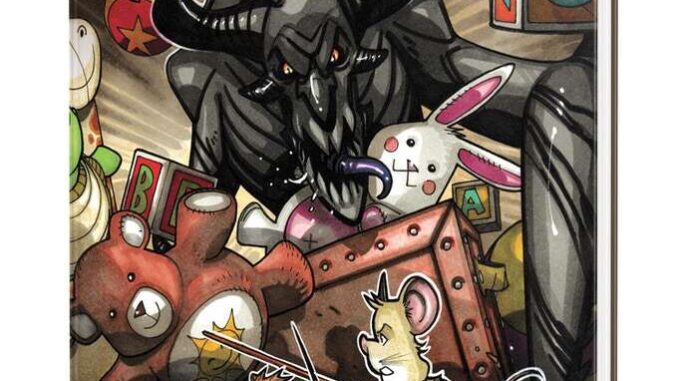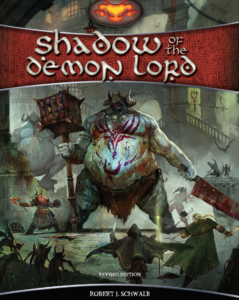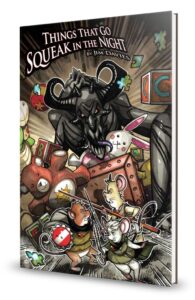
Jim Davies’ THINGS THAT GO SQUEAK IN THE NIGHT is a tabletop roleplaying game in which you play mice saving children and families from supernatural threats. I reviewed THINGS THAT GO SQUEAK IN THE NIGHT for Knights of the Dinner Table. For this article, I’ll avoid duplicating a review of the game in favor of talking about how SQUEAK’s engine succeeds. This RPG innovates through good combinations of existing game mechanics presented in new and interesting ways. Taking it further, beyond this game’s mechanics, let’s consider some other combos that might change the gaming experience.
THINGS THAT GO SQUEAK IN THE NIGHT was crowdfunded around the same time as Onyx Path Publishing’s Squeaks in the Deep Tabletop Roleplaying Game. Squeaks in the Deep is a sourcebook for Eddy Webb’s Pugmire and Monarchies of Mau. Squeaks in the Deep is an OGL RPG sourcebook. THINGS THAT GO SQUEAK IN THE NIGHT is a Powered by the ApocalypseRPG core rulebook. While both RPGs deal with mice as protagonists, they are distinct from each other. However, it’s important to acknowledge the similarity in title to clear up any confusion before I get into the article.
 Published by Gallant Knight Games, THINGS THAT GO SQUEAK IN THE NIGHT, which we’ll call SQUEAK going forward, puts together elements of the Powered by the Apocalypse (PbtA) system with the smell of mechanics from 7th Sea 2e and Green Ronin’s AGE system. I’m alluding to Moves with rolls that generate points to purchase actions. Since writing that SQUEAK review for Knights, I’ve thought on Jim’s innovations for the PbtA system and what could be developed from those concepts.
Published by Gallant Knight Games, THINGS THAT GO SQUEAK IN THE NIGHT, which we’ll call SQUEAK going forward, puts together elements of the Powered by the Apocalypse (PbtA) system with the smell of mechanics from 7th Sea 2e and Green Ronin’s AGE system. I’m alluding to Moves with rolls that generate points to purchase actions. Since writing that SQUEAK review for Knights, I’ve thought on Jim’s innovations for the PbtA system and what could be developed from those concepts.
In SQUEAK, you pick your Move like a PbtA RPG, but you roll 4d6 and count each 5 or 6 as 1 point for Perks. The Move you selected has a number of options (Perks) and you can choose as many as you rolled points for. If you’ve played any of Green Ronin’s AGE RPGs then you’ll feel the Stunts in this mechanic or, more broadly applied, John Wick’s 7th Sea 2e and its raises.
The idea of picking your Move and then rolling to see if it happens and, if so, how well it goes speaks to me. I like when players know if they succeed, it gives them more control over how to narrate their actions. Dungeons & Dragons and the World of Darkness embrace the concept of chasing the GM to determine what number you’re rolling against. The player rolls and has to check with the GM to see if they succeeded. Games like Call of Cthulhu and Chronicles of Darkness use static target numbers, allowing the player to determine if they succeeded or failed without as much GM intervention. Taking this further, Powered by the Apocalypse, Forged in the Dark, and Powered by Polymorph RPGs take advantage of static charts with customized results. Not only does the player know if they succeeded, but they know if there’s a cost for their success. In ways, SQUEAK goes further because the player knows the success and can choose which Perks they want to employ.
 Speaking of giving player’s control of their actions, let’s take a moment to praise Robert J. Schwalb’s Shadow of the Demon Lord’s initiative system. As a GM, my OGL games are so much smoother for starting each round with, “Ok, who has a Fast Action for me?” Each round, the players that have an action in the chamber get to announce their intentions while those that need time have it. Robert’s work puts strategy and agency in the player’s hands. Bravo big for that one!
Speaking of giving player’s control of their actions, let’s take a moment to praise Robert J. Schwalb’s Shadow of the Demon Lord’s initiative system. As a GM, my OGL games are so much smoother for starting each round with, “Ok, who has a Fast Action for me?” Each round, the players that have an action in the chamber get to announce their intentions while those that need time have it. Robert’s work puts strategy and agency in the player’s hands. Bravo big for that one!
I bring that up because it’s time to talk about combining concepts. Let’s take these game mechanics to the idea blender to see what flavor we get. SQUEAK’S Move system could be combined with Shadow of the Demon Lord’s initiative system. For this mental exercise, let’s assume a round-by-round approach to combat, something Shadow was designed for but most PbtA games are not.
Fast actions (a single action) would get either a Move at 4d6 or movement (characters goes from A location to B location). A Slow action (movement and another action that go after the enemy’s Fast action) would get 4d6 as well, meaning the Move and a movement. Alternately, we could conceive of getting two Moves (many at 3d6 per Move). Any rolled Move would have Perks to determine everything from effect to damage.
Leveling in modern rules lite RPGs is harder and harder to define given the thin amount of mechanics. However, with this system (4d6 where 5 and above give you one point), each level would let you upgrade one of your d6s to a d8. At 6th level, you’d convert one d8 to a d10 and the cycle continues. The use of dice with greater potential results against an unmoving static target number would improve your odds level after level.
 In this theoretical setup, only the players would roll. When the enemy gets a Move (between the player’s Fast and Slow Action), the players roll to resist. Combining PbtA, Perks, player rolls, and Fast/Slow Action initiative could create an RPG that lets the GM simply narrate, not lawyer. The players would carry the onus of the action and be able to determine their success and when to maneuver. As a loose framework, this needs refining, but it could open up new options for the PbtA ruleset. Based on THINGS THAT GO SQUEAK IN THE NIGHT, Powered by the Apocalypse, and Shadow of the Demon Lord, this might give rise to a solid combat system that lets the players maximize their agency.
In this theoretical setup, only the players would roll. When the enemy gets a Move (between the player’s Fast and Slow Action), the players roll to resist. Combining PbtA, Perks, player rolls, and Fast/Slow Action initiative could create an RPG that lets the GM simply narrate, not lawyer. The players would carry the onus of the action and be able to determine their success and when to maneuver. As a loose framework, this needs refining, but it could open up new options for the PbtA ruleset. Based on THINGS THAT GO SQUEAK IN THE NIGHT, Powered by the Apocalypse, and Shadow of the Demon Lord, this might give rise to a solid combat system that lets the players maximize their agency.
Egg Embry participates in the OneBookShelf Affiliate Program, Noble Knight Games’ Affiliate Program, and is an Amazon Associate. These programs provide advertising fees by linking to DriveThruRPG, Noble Knight Games, and Amazon.
